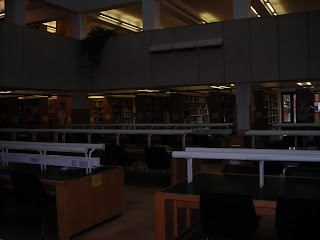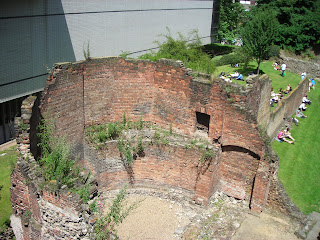http://www.strath.ac.uk/cis/Dr. David
McMenemy (whose background is in public libraries) and Alan
Poulter (cataloging, digital and other systems, and special libraries), along with a couple of their students and colleagues, were kind enough to host us at the University of
Strathclyde and talk about their library science program and the various aspects related to librarianship in Scotland. (They were also kind enough to feed us tea and lunch!) They talked about everything from the classification systems used by libraries to television shows like Dr. Who and Coupling (Dr.
McMenemy even knew the woman that the character Jane was based on).
They discussed some of the challenges of their profession, and they said there is a 'crisis of confidence' in the UK. They have a hard time keeping people involved in the profession, and many people consider themselves managers instead of librarians.
CILIP (their ALA) is smaller and their conferences less well attended, and some people question if libraries even need professional librarians. Recent years have seen the decline of
professionalism and an
uprise in
managerials who are seeing users as customers. Some public libraries have been taken over by business consultants, who turn libraries into coffee with some books. On the other hand, some libraries have become community centers that try to make the disadvantaged less disadvantaged.
Dr.
McMenemy is the course director of their
MSc program (their information and library science degree), and he gave us a background of the university and an overview of libraries in the UK. The University has been around since 1796 in various incarnations, and since 2006, it is Scotland's third largest university. They have about 25,000 students (15,000 undergraduates and 10,000 postgraduates). The UK has 4,515 public libraries and 846 academic libraries. No statistics have been collected on school libraries, because there are no requirements for schools to have libraries in the UK. (This surprised and saddened most of us, especially those in our class who want to become school media specialists.) Academic librarians are the ones with the status and the salaries. Public libraries are legally obliged to provide "comprehensive and efficient" public library service to anyone who lives, works, or studies in their community under the 1964 Public Libraries and Museums Act (England and Wales) and the
Local Government Act of 1973 (Scotland). Of course, like in the United States, there are problems with people using the service who don't actually pay for it.
He also went over the public service divisions in the UK. England has 46 unitary authorities, 36 metropolitan districts, and 36 shire counties. Scotland has 32 unitary councils, and Wales has 22 unitary councils. Then he discussed the impact of the Devolution Scotland Act of 1998 and the Government Wales Act of 1998 that created parliaments in Edinburgh and Cardiff. The
publicly funded library services are now governed by the devolved parliaments, so London no longer affects the libraries of Scotland and Wales.
He then listed some key professional issues that librarians are facing today: significant drops in borrowing figures, how to attract non-users, the digital divide,
deprofessionalization, and how to measure library services effectively.
The latter issue was presented on by PhD student Christine Rooney-Browne, who is studying measuring the social value of public libraries. She described the traditional role of public libraries as one of intellectual freedom, cultural diversity, democratic values, etc., and she argued that the
social impact of libraries can't be measured by statistics, as what people get out of books, access, and service are difficult to discern. She discussed various methods and techniques of measuring value, including the Public Library Quality, Improvement Matrix, questionnaires, focus groups, interviews, and Social Impact Audits. She decided to focus her study in five areas: rural, urban,
developing, natural disaster, and indigenous people. For the impact of libraries on rebuilding communities, she focused on New Orleans. She also studied two libraries that are five miles apart but are radically different. The library in the affluent neighborhood was a transactional bookshop space with high stocks of bestsellers, which the deprived neighborhood library was a welcoming social space that provided a gateway to information, literacy, and escapism. Her study sounded really interested, and I'm curious to read what her conclusions turn out to be.
Alan
Poulter then discussed a program he and some others are working on called FRILLS (
Forsenic Readiness for Local Libraries in Scotland) that investigates crime through the analysis of computers. (In addition to his library degree,
Poulter also has a masters in computer science.) The People's Network was an initiative to offer free access to Internet in all public libraries. Despite Acceptable Use Policies, this led to problems based on what people did on these computers (looking at pornography, etc.), so various groups have worked on ways to find out and track what people do on these computers. Some libraries have tried to solve the problem by using web filters, but these of course restrict access, so his group is working on a logging system that requires a low level of monitoring. He discussed how they developed their
forsenic readiness regime by interviewing subjects, reading literature reviews, talking to heads of library services, and working with pilot sites. They learned that people were breaking the Acceptable Use Policies and that these policies were not well understood by users or kept up to date. There was also no standard recording of misuse. He then discussed how his program worked (basically, if I understood it right, it creates a stored
encrypted log of what was done on the machine). It sounds like a good solution to a very perplexing library problem.
Alan Dawson next gave us an overview of the Centre for Digital Library Research, and he showed us various online resources like
BUBL (a catalog which had been around 17 years before the world wide web and is still very popular). He also showed us the Glasgow Digital Library, which has digitalized pamphlets and other historic material, and he demonstrated how the index is dynamically linked to the content.
After a lovely lunch, we took a trip over to The Bridge, which is a library and community center complex that was developed in one of the disadvantaged areas of Glasgow. The library is the hub of a building that also
contains a swimming pool, college, theatre, and studio. It is unique in the UK, as it is the only building that fully integrates all of these facilities. They teach people to use PCs to get them on the path to college. The library has shelves (some of them rolling shelves, especially in the children's area)
interspersed with sitting areas and craft areas. Our guide Stephen
Finnie told us that the space has also been used as part of a theatre set. They constantly change and rotate their stock to prevent space and storage issues. They also house the college library. Most of it is fully integrated, but some of the class material is kept apart in a separate area, as it was bought with different funding. They have about 30,000 items, and new books are purchased every week.
The building design is reminiscent of a tree-house and/or forest, and it is a rather loud and echoing space (although they do have some quiet study space). They also have a small community room known as The Den. They have six professional librarians on staff (the small numbers emphasized what we had heard in the previous lectures about the
of public libraries). We were given a tour of all of their facilities that were open. It certainly is a beautiful space and concept - very open and welcoming. It's a neat concept to integrate all of those facilities into one large community space.




























